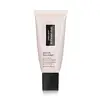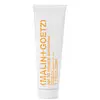Shu Uemura Unlimited Block : Booster Hydrating Primer SPF 50+ PA+++ Versus (Malin+Goetz) SPF 30 Mineral Sunscreen
What's inside
What's inside
 Key Ingredients
Key Ingredients

 Benefits
Benefits

 Concerns
Concerns

 Ingredients Side-by-side
Ingredients Side-by-side

Water
Skin ConditioningAlcohol Denat.
AntimicrobialEthylhexyl Salicylate
UV AbsorberIsononyl Isononanoate
EmollientOctocrylene
UV AbsorberButyl Methoxydibenzoylmethane
UV AbsorberEthylhexyl Triazone
UV AbsorberBis-Ethylhexyloxyphenol Methoxyphenyl Triazine
Skin ConditioningCI 77891
Cosmetic ColorantMethylene Bis-Benzotriazolyl Tetramethylbutylphenol
UV FilterPropanediol
SolventIsopropyl Lauroyl Sarcosinate
Skin ConditioningSilica
AbrasiveCetearyl Alcohol
EmollientDiisopropyl Sebacate
EmollientCoco-Caprylate/Caprate
EmollientMica
Cosmetic ColorantPhenoxyethanol
PreservativeHomosalate
Skin ConditioningButylene Glycol
HumectantPolyglyceryl-10 Laurate
Skin ConditioningAmmonium Acryloyldimethyltaurate/Vp Copolymer
Cetearyl Glucoside
EmulsifyingTocopherol
AntioxidantGlycerin
HumectantSodium Stearoyl Glutamate
CleansingCaprylyl Glycol
EmollientCarbomer
Emulsion StabilisingInulin Lauryl Carbamate
Emulsion StabilisingTin Oxide
AbrasiveCaramel
Cosmetic ColorantPropylene Glycol
HumectantAdenosine
Skin ConditioningTrisodium Ethylenediamine Disuccinate
Xanthan Gum
EmulsifyingAlumina
AbrasiveIsopropyl Titanium Triisostearate
EmollientSorbitol
HumectantMaris Aqua
HumectantT-Butyl Alcohol
PerfumingZea Mays Kernel Extract
CI 17200
Cosmetic ColorantPaeonia Suffruticosa Root Extract
Skin ProtectingNelumbo Nucifera Flower Extract
Skin ConditioningSorbic Acid
PreservativeCitric Acid
BufferingHelianthus Annuus Seed Oil
EmollientWater, Alcohol Denat., Ethylhexyl Salicylate, Isononyl Isononanoate, Octocrylene, Butyl Methoxydibenzoylmethane, Ethylhexyl Triazone, Bis-Ethylhexyloxyphenol Methoxyphenyl Triazine, CI 77891, Methylene Bis-Benzotriazolyl Tetramethylbutylphenol, Propanediol, Isopropyl Lauroyl Sarcosinate, Silica, Cetearyl Alcohol, Diisopropyl Sebacate, Coco-Caprylate/Caprate, Mica, Phenoxyethanol, Homosalate, Butylene Glycol, Polyglyceryl-10 Laurate, Ammonium Acryloyldimethyltaurate/Vp Copolymer, Cetearyl Glucoside, Tocopherol, Glycerin, Sodium Stearoyl Glutamate, Caprylyl Glycol, Carbomer, Inulin Lauryl Carbamate, Tin Oxide, Caramel, Propylene Glycol, Adenosine, Trisodium Ethylenediamine Disuccinate, Xanthan Gum, Alumina, Isopropyl Titanium Triisostearate, Sorbitol, Maris Aqua, T-Butyl Alcohol, Zea Mays Kernel Extract, CI 17200, Paeonia Suffruticosa Root Extract, Nelumbo Nucifera Flower Extract, Sorbic Acid, Citric Acid, Helianthus Annuus Seed Oil
Titanium Dioxide 3.71%
Cosmetic ColorantZinc Oxide 2.71%
Cosmetic ColorantWater
Skin ConditioningGlycerin
HumectantCaprylic/Capric Triglyceride
MaskingButyrospermum Parkii Butter
Skin ConditioningNiacinamide
SmoothingCoconut Alkanes
EmollientAlumina
AbrasiveGlycogen
HumectantIsohexadecane
EmollientPolysorbate 60
EmulsifyingSorbitan Isostearate
EmulsifyingHydroxyethyl Acrylate/Sodium Acryloyldimethyl Taurate Copolymer
Emulsion StabilisingSodium Hyaluronate
HumectantDiethylhexyl Syringylidenemalonate
Skin ProtectingTriethoxycaprylylsilane
Ursolic Acid
MaskingStearic Acid
CleansingPolyhydroxystearic Acid
EmulsifyingHydrogenated Lecithin
EmulsifyingBenzyl Alcohol
PerfumingPhenoxyethanol
PreservativeTocopheryl Acetate
AntioxidantCoco-Caprylate/Caprate
EmollientAminomethyl Propanol
BufferingXanthan Gum
EmulsifyingCitric Acid
BufferingTitanium Dioxide 3.71%, Zinc Oxide 2.71%, Water, Glycerin, Caprylic/Capric Triglyceride, Butyrospermum Parkii Butter, Niacinamide, Coconut Alkanes, Alumina, Glycogen, Isohexadecane, Polysorbate 60, Sorbitan Isostearate, Hydroxyethyl Acrylate/Sodium Acryloyldimethyl Taurate Copolymer, Sodium Hyaluronate, Diethylhexyl Syringylidenemalonate, Triethoxycaprylylsilane, Ursolic Acid, Stearic Acid, Polyhydroxystearic Acid, Hydrogenated Lecithin, Benzyl Alcohol, Phenoxyethanol, Tocopheryl Acetate, Coco-Caprylate/Caprate, Aminomethyl Propanol, Xanthan Gum, Citric Acid
Ingredients Explained
These ingredients are found in both products.
Ingredients higher up in an ingredient list are typically present in a larger amount.
Alumina is another name for the compound aluminum oxide. It is used as a thickener, absorbent, and abrasive.
As an absorbent, alumina can give a mattifying effect. It is used in mineral sunscreens to help coat nano-sized filters, such as titanium dioxide. By increasing the size of the UV filters, these ingredients stay on the skin for a longer time. By coating small sized ingredients, alumina helps thicken a product.
Alumina may be used as an abrasive, or exfoliant.
Alumina is naturally occurring in the mineral corundum. Certain varieties of corundum create rubies and sapphires. Corundum is also the crystalline form of alumina.
Learn more about AluminaCitric Acid is an alpha hydroxy acid (AHA) naturally found in citrus fruits like oranges, lemons, and limes.
Like other AHAs, citric acid can exfoliate skin by breaking down the bonds that hold dead skin cells together. This helps reveal smoother and brighter skin underneath.
However, this exfoliating effect only happens at high concentrations (20%) which can be hard to find in cosmetic products.
Due to this, citric acid is usually included in small amounts as a pH adjuster. This helps keep products slightly more acidic and compatible with skin's natural pH.
In skincare formulas, citric acid can:
While it can provide some skin benefits, research shows lactic acid and glycolic acid are generally more effective and less irritating exfoliants.
Most citric acid used in skincare today is made by fermenting sugars (usually from molasses). This synthetic version is identical to the natural citrus form but easier to stabilize and use in formulations.
Read more about some other popular AHA's here:
Learn more about Citric AcidCoco-Caprylate/Caprate is created from fatty coconut alcohol, caprylic acid, and capric acid.
It is a lightweight emollient. Emollients create a thin barrier on the skin to trap moisture in. This helps keep your skin hydrated and soft.
Once applied, Coco-Caprylate/Caprate is absorbed quickly and leaves a silky feel.
Coco-Caprylate/Caprate may not be fungal acne safe.
Learn more about Coco-Caprylate/CaprateGlycerin is already naturally found in your skin. It helps moisturize and protect your skin.
A study from 2016 found glycerin to be more effective as a humectant than AHAs and hyaluronic acid.
As a humectant, it helps the skin stay hydrated by pulling moisture to your skin. The low molecular weight of glycerin allows it to pull moisture into the deeper layers of your skin.
Hydrated skin improves your skin barrier; Your skin barrier helps protect against irritants and bacteria.
Glycerin has also been found to have antimicrobial and antiviral properties. Due to these properties, glycerin is often used in wound and burn treatments.
In cosmetics, glycerin is usually derived from plants such as soybean or palm. However, it can also be sourced from animals, such as tallow or animal fat.
This ingredient is organic, colorless, odorless, and non-toxic.
Glycerin is the name for this ingredient in American English. British English uses Glycerol/Glycerine.
Learn more about GlycerinPhenoxyethanol is a preservative that has germicide, antimicrobial, and aromatic properties. Studies show that phenoxyethanol can prevent microbial growth. By itself, it has a scent that is similar to that of a rose.
It's often used in formulations along with Caprylyl Glycol to preserve the shelf life of products.
Water. It's the most common cosmetic ingredient of all. You'll usually see it at the top of ingredient lists, meaning that it makes up the largest part of the product.
So why is it so popular? Water most often acts as a solvent - this means that it helps dissolve other ingredients into the formulation.
You'll also recognize water as that liquid we all need to stay alive. If you see this, drink a glass of water. Stay hydrated!
Learn more about WaterXanthan gum is used as a stabilizer and thickener within cosmetic products. It helps give products a sticky, thick feeling - preventing them from being too runny.
On the technical side of things, xanthan gum is a polysaccharide - a combination consisting of multiple sugar molecules bonded together.
Xanthan gum is a pretty common and great ingredient. It is a natural, non-toxic, non-irritating ingredient that is also commonly used in food products.
Learn more about Xanthan Gum